Otay Poster Contest Winners Demonstrate the Value of Water Conservation
Five students from Chula Vista and El Cajon schools have been selected from 123 submissions as the winners of Otay Water District’s 2022 Water is Life Student Poster Contest.
Five students from Chula Vista and El Cajon schools have been selected from 123 submissions as the winners of Otay Water District’s 2022 Water is Life Student Poster Contest.
Susan and Steve Matloff are doing what they do most days when they are at home: spending time in their front yard with their kids, talking with neighbors, playing with their dog Blue and passing home-grown onions to random passersby.
When they installed raised vegetable beds alongside the sidewalk, they fantasized about living off the land despite warnings from friends that people might steal their produce.
“If someone wants to take a bell pepper, good on them,” says Steve, 49. “My office overlooks the garden, and every day I see people stop and look at our garden. Sometimes I run out there and talk to them. Our daughter Isabelle has been known to pull out a carrot and hand it to people walking by. The conversations start there. It’s part of what we wanted for our yard: to be a statement and community builder.”
Five students from Chula Vista and El Cajon schools have been selected from 123 submissions as the winners of Otay Water District’s 2022 Water is Life Student Poster Contest. The annual contest helps to promote water-use efficiency through student art programs. The winners were selected based on their creativity and awareness of the importance of using water wisely every day and in times of drought.
The Otay Water District’s educational program invites K-12 grade students in its service area each year to enter the contest by illustrating the theme “Water is Life.” Entrants are encouraged to reflect on the importance of water conservation and stewardship and learn about this in the classroom prior to creating their posters.
“We are proud to see a young generation of students share their awareness about water conservation and stewardship when it matters most,” said contest coordinator Eileen Salmeron. “As California faces a drought, we hope students and their families understand that making small changes at home or school to conserve can make a big difference in building resiliency against drought.”
First- and second-place winners were selected from elementary and middle school categories. One winner was chosen in the high school category. The District’s board of directors recognized the winners at its September 7 meeting. Winners received prizes including a gift card, a certificate of recognition, an art kit, and a goody bag.

First place, high school: Michael Armenion, eleventh grade, Otay Ranch High School. Photo: Otay Water District
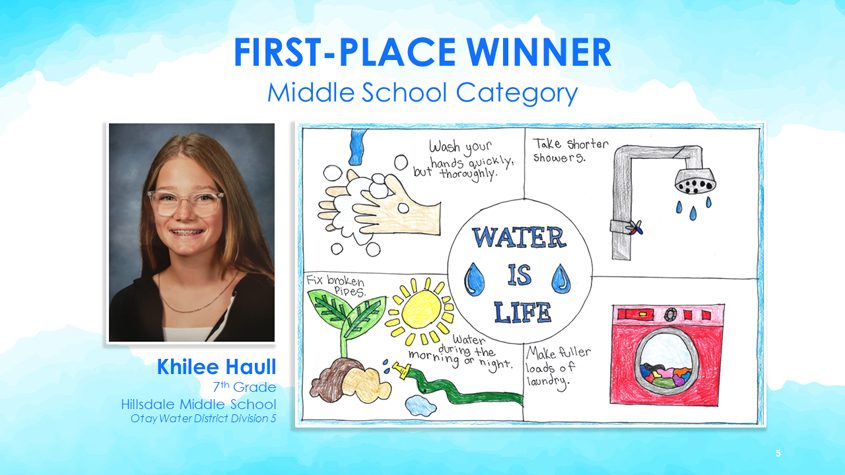
First place, middle school: Khilee Haull, seventh grade, Hillsdale Middle School. Photo: Otay Water District
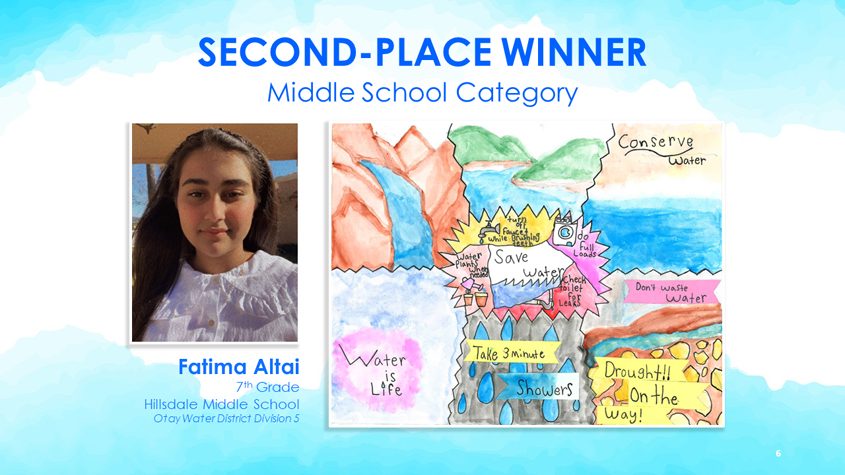
Second place, middle school: Fatima Altai, seventh grade, Hillsdale Middle School. Photo: Otay Water District
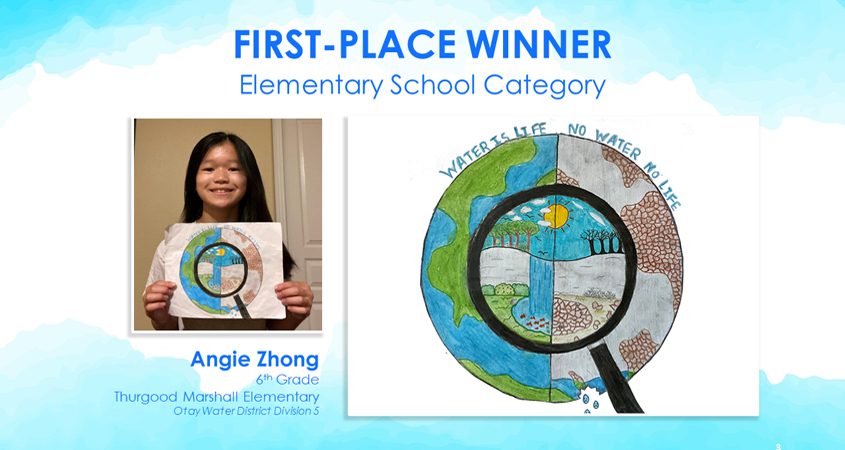
First place, elementary school: Angie Zhong, sixth grade, Thurgood Marshall Elementary School. Photo: Otay Water District
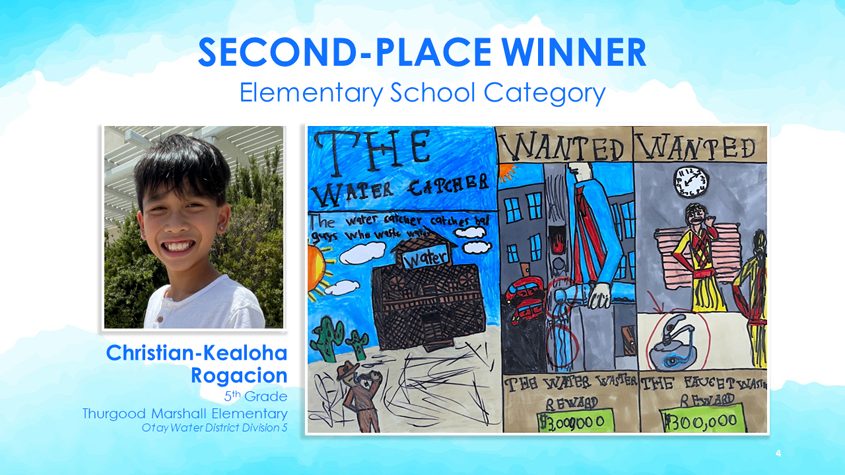
Second place, elementary school: Christian-Kealoha Rogacion, fifth grade, Thurgood Marshall Elementary School. Photo: Otay Water District
The Otay Poster Contest winners compete for regional awards in the Metropolitan Water District of Southern California’s annual student poster contest. Thirty-six posters are chosen from participating Southern California water agencies for inclusion in the 2023 MWD Water is Life calendar. This year, MWD selected Khilee Haull and Christian-Kealoha Rogacion to represent Otay Water District in MWD’s 2023 calendar.
(Editor’s note: The Otay Water District is one of the San Diego County Water Authority’s 24 member agencies that deliver water across the metropolitan San Diego region.)
Using water efficiently is a way of life and an important responsibility in a beautiful, Mediterranean climate like San Diego County. WaterSmart landscaping is all about rethinking the way limited water resources are applied and making smart choices to reduce outdoor water use.
Using water efficiently is a way of life and an important responsibility in a beautiful, Mediterranean climate like San Diego County. WaterSmart landscaping is all about rethinking the way limited water resources are applied and making smart choices to reduce outdoor water use.
Saving water isn’t the only reason for a WaterSmart garden. WaterSmart landscapes are attractive and in balance with our environment and climate. They incorporate elements of sustainable landscaping such as healthy, living soils, climate-appropriate plants, high-efficiency irrigation and rainwater harvesting, and generate many environmental and community benefits.
Working within the WaterSmart Matrix, you have lots of flexibility when selecting the combination of plants and irrigation to meet your water efficiency goals. Whether you want to create space for entertaining, limit landscape maintenance, or maintain some turf for children and pets, you can reach your water-saving goals and create an outdoor space to live in without resorting to gravel, concrete, or artificial turf.
These three models can help you get started. You can swap plants within the same usage categories, as long as the percentage mix of low, moderate, and high water use plants remain the same.
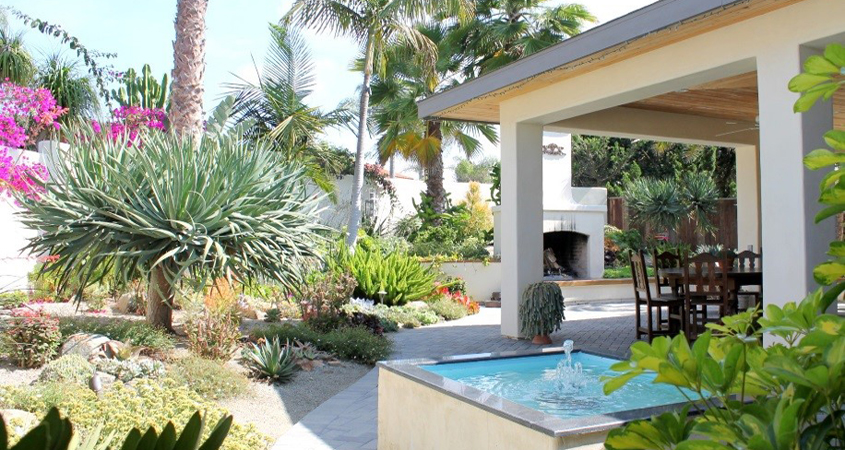
The Bucks’ winning landscape design includes beautiful outdoor living areas. Photo: Olivenhain Municipal Water District
Low water-use plants: 45%.
Moderate water-use plants: 45%
High water-use plants: 10%
In this style, small areas of turf in the high water use category are balanced by beautiful trees, flowering shrubs, and groundcover choices which thrive in our San Diego-style Mediterranean climate. This is a landscape perfect for outdoor entertaining.
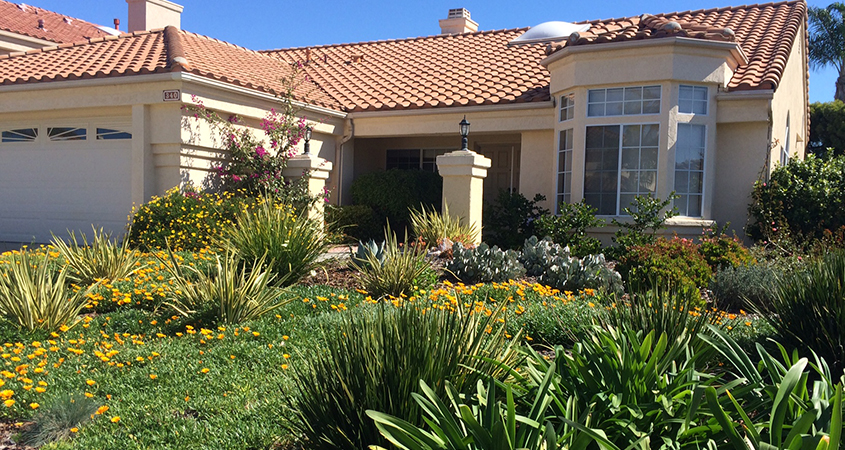
This homeowner took advantage of turf rebates to transform the front yard with climate-appropriate plants. Photo: San Diego County Water Authority.
Low water-use plants: 90%.
High water-use plants: 10%
For even greater water savings, shrubs that thrive in our San Diego-style Mediterranean climate take center stage along with smart choices of drought-tolerant trees and minimal turf for a lush landscape look full of texture and color.
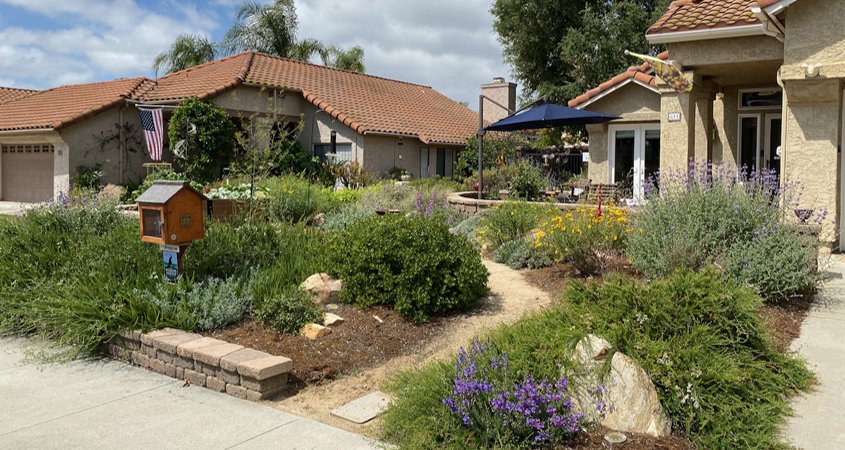
The Everetts’ winning landscape provides a native habitat and saves water. Photo: City of Escondido
Very low water-use plants: 50%.
Low water-use plants: 50%
California native plants and succulents thrive in our environments. They have adapted over thousands of years to survive on limited natural rainfall. Using natives to create natural habitat is the ultimate accomplishment in WaterSmart landscaping design.
Refer to the plant lists in A Homeowner’s Guide to a WaterSmart Landscape, or ask a local nursery professional for help choosing your landscape plants from the appropriate categories.
WaterSmart landscapes are an upgrade, not a compromise. Creating a yard that loves San Diego as much as you do also creates a sustainable habitat that also preserves our native environment. It can save you maintenance time and costs and conserves our most valuable community resource: water.
________________________________________________________

(Editor’s Note: The San Diego County Water Authority and its 24 member agencies offer programs, resources, and incentives to improve water-use efficiency for residential, commercial, and agricultural users. WaterSmart choices are a way of life in the region. Stay WaterSmart San Diego! For more water-use efficiency resources, go to WaterSmart.SD.org.)
Water use in the Coachella Valley continued to tick downwards in July, but conservation is still falling short of the state’s goal of a 15% reduction compared to 2020, according to data released by the State Water Resources Control Board this week.
But the July water use numbers do continue a trend of reduced water use that began in June, a marked shift from May and other previous months in which local water districts actually increased — rather than decreased — water use compared to 2020 baseline numbers.
Californians stepped up their water conservation in July, using 10.4% less than two years ago as the state struggles with a years-long drought, state water officials said Wednesday.
July marks the first full month that new conservation rules like a ban on watering decorative grass were in effect, which state water officials said helped make a difference. Water use started to trend down in June after a bump in April and May.
Poseidon Resources (Channelside) LP and the San Diego County Water Authority are temporarily reducing water production at the Claude “Bud” Lewis Carlsbad Desalination Plant to support statewide emergency energy conservation efforts during the extreme heat wave.
While the plant accounts for less than 1% of peak energy demand in San Diego Gas & Electric’s service territory, Channelside and the Water Authority are committed to supporting electrical reliability while ensuring continued delivery of safe and reliable water supplies. The partners reduced water production at the plant by about 20% for three days over the Labor day holiday weekend. Regular water deliveries were made from other sources. The reduced production helps decrease energy demand during the statewide emergency.
“The partnership by the Water Authority and Channelside is another reminder of the value our investments in cutting-edge technology and water supply reliability,” said Sandra L. Kerl, general manager of the Water Authority. “Desal plant operations are nimble, so production can be ramped up and down in response to local needs. This flexibility underscores the value of regional water supply planning, which allows us to activate solutions during challenging times.”
The Carlsbad Desalination Plant is the largest, most technologically advanced and energy-efficient desalination plant in the nation. The plant has produced more than 90 billion gallons of drinking water for San Diego County since operations began in December 2015. Starting Sunday, Sept. 4, the plant ramped down operations, making an additional 9 megawatts of power available for other uses.
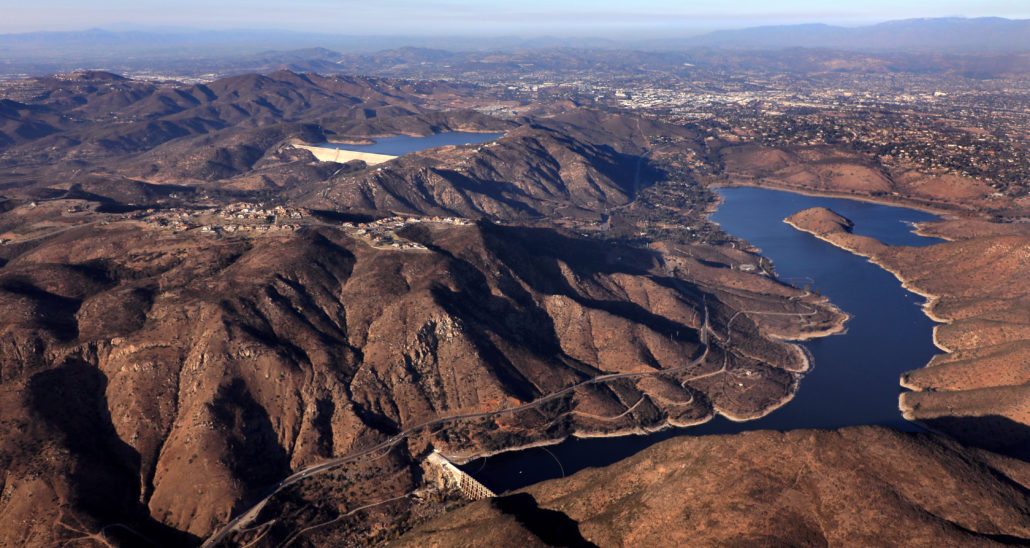
The Water Authority is running its Lake Hodges Pumped Storage Facilities to generate 20 megawatts of on-demand power, helping meet peak demands. Photo: San Diego County Water Authority
The Water Authority also is running its Lake Hodges Pumped Storage Facilities to generate 20 megawatts of on-demand power, helping meet peak demands.
In addition, the Water Authority and the City of San Diego are collaboratively advancing the proposed San Vicente Energy Storage Facility in East County, one of the most promising pumped energy storage solutions in California. Pumped energy storage projects are designed to store excess renewable energy from solar and wind during the day, and then discharge that energy when energy use spikes or renewable energy is not available. As proposed, the project could store 4,000 megawatt-hours per day of energy (500 megawatts of capacity for eight hours), which is enough energy to provide approximately 135,000 homes with power.
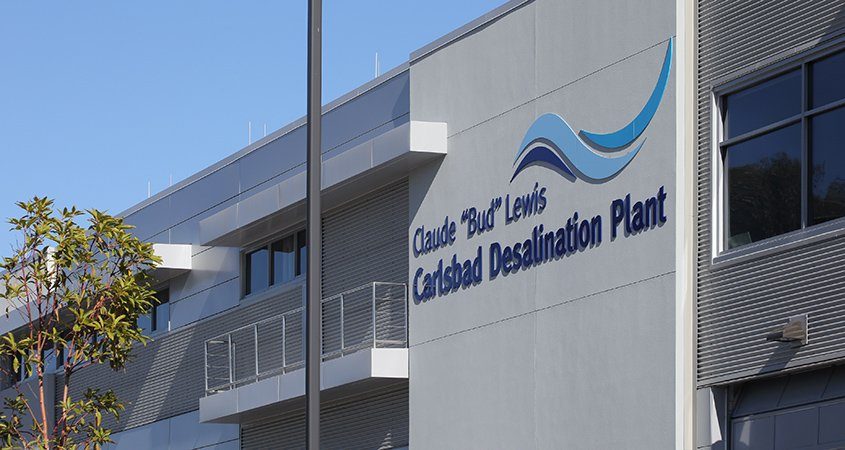
The Claude “Bud” Lewis Carlsbad Desalination Plant uses energy recovery devices that save an estimated 146 million kilowatt-hours and reduce carbon emissions by 42,000 metric tons every year. Photo: San Diego County Water Authority
The Carlsbad Desalination Plant eliminates the need to transport water from Northern California to the San Diego region, offsetting approximately 190,000 megawatt-hours of electricity and 68,000 tons of carbon emissions each year. The plant also uses energy recovery devices that save an estimated 146 million kilowatt-hours and reduce carbon emissions by 42,000 metric tons every year.
“This is an example of how desalination plants can help contribute to energy reliability, in addition to water reliability, by taking appropriate action to increase the available energy capacity during the extreme heat event,” said Channelside President, Sachin Chawla. “We’re proud to do whatever we can to help our region address the current energy shortage.”
Carlsbad, Calif. (Sept. 4, 2022) – Poseidon Resources (Channelside) LP and the San Diego County Water Authority are temporarily reducing water production at the Claude “Bud” Lewis Carlsbad Desalination Plant to support statewide emergency energy conservation efforts during the extreme heat wave.
While the plant accounts for less than 1% of peak energy demand in San Diego Gas & Electric’s service territory, Channelside and the Water Authority are committed to supporting electrical reliability while ensuring continued delivery of safe and reliable water supplies. The partners are reducing water production at the plant by about 20% for three days over the holiday weekend; regular water deliveries will be made from other sources.
“The partnership by the Water Authority and Channelside is another reminder of the value our investments in cutting-edge technology and water supply reliability,” said Sandra L. Kerl, general manager of the Water Authority. “Desal plant operations are nimble, so production can be ramped up and down in response to local needs. This flexibility underscores the value of regional water supply planning, which allows us to activate solutions during challenging times.”
The North San Diego Water Reuse Coalition was awarded a grant of up to $17.8 million for the development of recycled water infrastructure. The grant funds come from the U.S. Bureau of Reclamation.
“As we face increasingly devastating drought conditions, it’s imperative that we continue to diversify our water supplies and strengthen our local water independence,” said U.S. Representative Mike Levin. “The North San Diego Water Reuse Coalition plays a critical role in that effort, which is why I am proud to see the Bipartisan Infrastructure Law funding investments for their important work to expand the use of recycled water.”
This is the second grant that the USBR has awarded to the North County coalition in the last year. In August 2021, USBR committed $6.1 million in funds from its Title XVI program for local water reclamation and reuse projects. The two grant awards totaling up to $23.9 million will help cover costs for work performed through September 2025.
“California is not going to be able to navigate another historic drought if we don’t develop new water supplies, said Larry Watt, Olivenhain Municipal Water District’s Board President. “In fact, the number one priority in the California Water Supply Strategy document that Governor Newsom recently released is to create new water recycling projects. This financial support from the Bureau of Reclamation is instrumental for us to be able to develop these new supplies and achieve statewide goals.”
The coalition is a group of nine water and wastewater agencies in San Diego County working beyond jurisdictional boundaries to maximize recycled water use and reduce demand for imported water. The awarded funding is for the coalition’s Regional Recycled Water Program: 2020 Project, which is a joint effort between coalition members to expand recycled water infrastructure to increase and maximize water reuse in the region. Upon completion of all long-term project elements, the coalition anticipates increasing water reuse by 11 billion gallons per year. This equates to approximately 31 million gallons per day of recycled water and potable reuse water added to northern San Diego’s water supply portfolio.
The project includes connecting discrete recycled water systems to one another, new pipelines, increasing recycled water storage capacity, installation of new pump stations, and other project components that will help distribute recycled water to effectively meet demands.
“For the Vallecitos Water District, the additional funding will be used to increase the size of the chlorine contact stage at our Meadowlark Water Reclamation Facility,” noted Craig Elitharp, Vallecitos Water District Board President. “We will be able to increase the capacity of Meadowlark from 5 million gallons a day to 6.5 million gallons a day. This additional reclaimed water supply will be passed along to our water reuse partners with the City of Carlsbad and the Olivenhain Municipal Water District.”
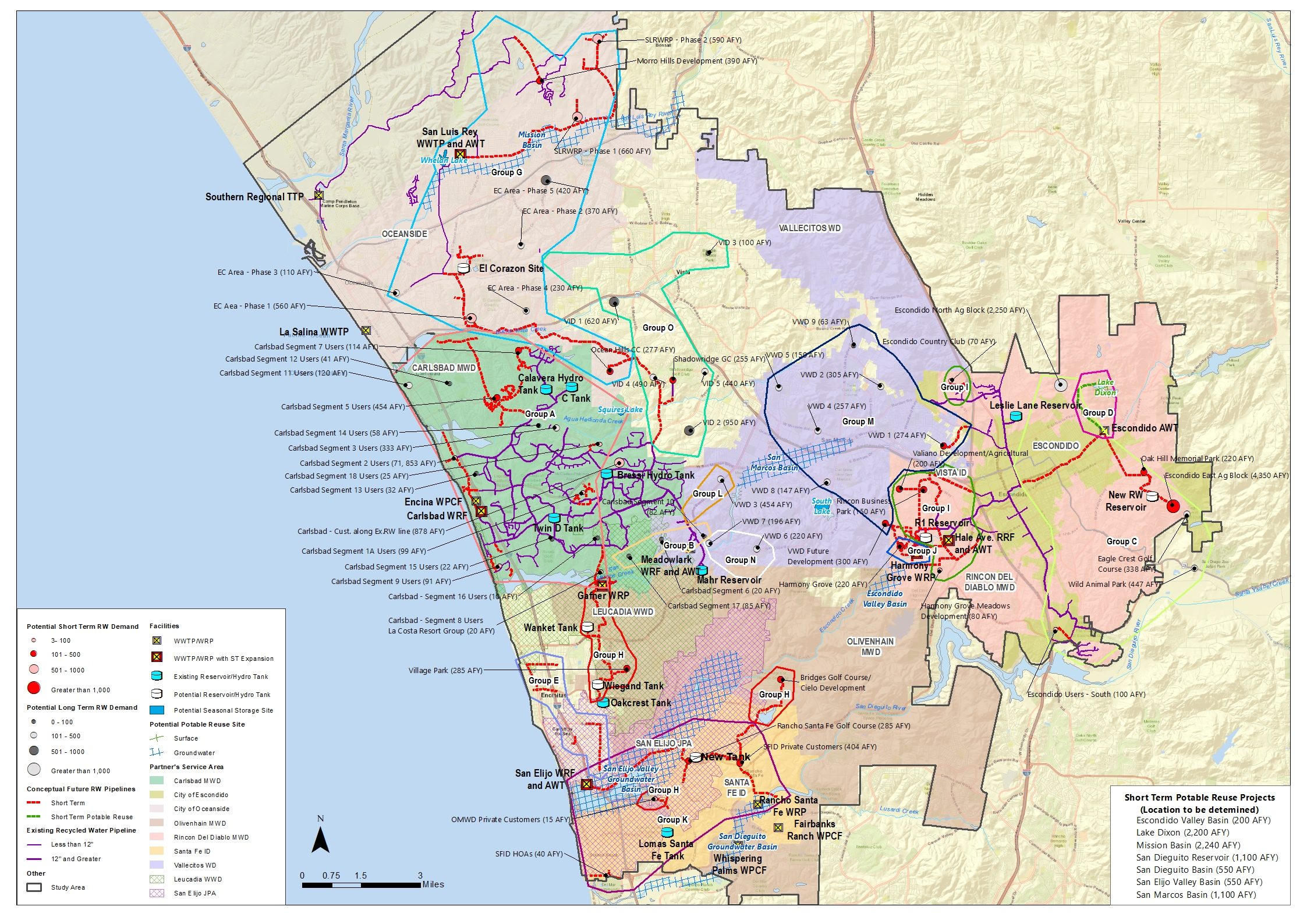
The project includes connecting discrete recycled water systems to one another, new pipelines, increasing recycled water storage capacity, installation of new pump stations, and other project components that will help distribute recycled water to effectively meet demands. Graphic: North San Diego Water Reuse Coalition
The project helps address water supply shortages by offering the region a reliable approach for supplementing local and imported supplies. Potable water supplies are vulnerable during drought periods and can be restricted during times of water shortages. Recycled water is considered a drought-proof supply because it is not linked to weather fluctuations and is available year-round, effectively offsetting potable water demand. Furthermore, since recycled water is produced locally, it cannot be disrupted from shortages caused by earthquakes, wildfires, and other natural disasters that may occur in other parts of the state.
“We are grateful for this partnership with the U.S. Bureau of Reclamation to help fund green infrastructure,” said Kellie Hinze, San Elijo Joint Powers Authority Chairwoman and Encinitas City Council Member. “Recycling water reduces our dependence on imported supplies while building resiliency for a changing climate.”
Investments in water infrastructure, such as the infrastructure expanded by this project, promotes economic development and expanded business opportunities. According to the San Diego Regional Economic Development Corporation, for every $1 invested in water infrastructure, there is an estimated $1.80 increase in the region’s gross regional product.
Additional benefits associated with the project come from reduced wastewater discharges and associated coastal stressors. Reducing the amount of wastewater discharged to the Pacific Ocean can benefit water quality along the coast in the coalition’s service area.
In addition to federal funds, the project has previously received funding at the state level from the Department of Water Resources. The project received grant funding on several occasions through DWR’s Integrated Regional Water Management Program—administered locally in partnership with the San Diego County Water Authority, County of San Diego, and City of San Diego—which supports collaborative water management to increase regional self-reliance throughout California. These IRWM awards have totaled $4.95 million in grant funding.
Through the Title XVI Water Reclamation and Reuse Program, the USBR provides financial and technical assistance to local water agencies for the planning, design, and construction of water reclamation and reuse projects. These projects are designed to provide growing communities with new sources of water which increases water management flexibility and makes our water supply more reliable. The coalition will be working with USBR to finalize the grant agreement in the coming months.
More information about the coalition and the project is available at www.nsdwrc.org.
The North San Diego Water Reuse Coalition is comprised of nine northern San Diego County water and wastewater agencies working beyond jurisdictional boundaries to maximize recycled water use and reduce demand for imported water. The Coalition partners include Olivenhain Municipal Water District, Carlsbad Municipal Water District, City of Oceanside, Vallecitos Water District, City of Escondido, Rincon del Diablo Municipal Water District, Santa Fe Irrigation District, Leucadia Wastewater District, and San Elijo Joint Powers Authority.
(Editor’s note: The Santa Fe Irrigation District, Vallecitos Water District, Olivenhain Municipal Water District, Rincon del Diablo Municipal Water District, Carlsbad Municipal Water District, City of Escondido, and City of Oceanside, are seven of the San Diego County Water Authority’s 24 member agencies that deliver water across the metropolitan San Diego region.)
